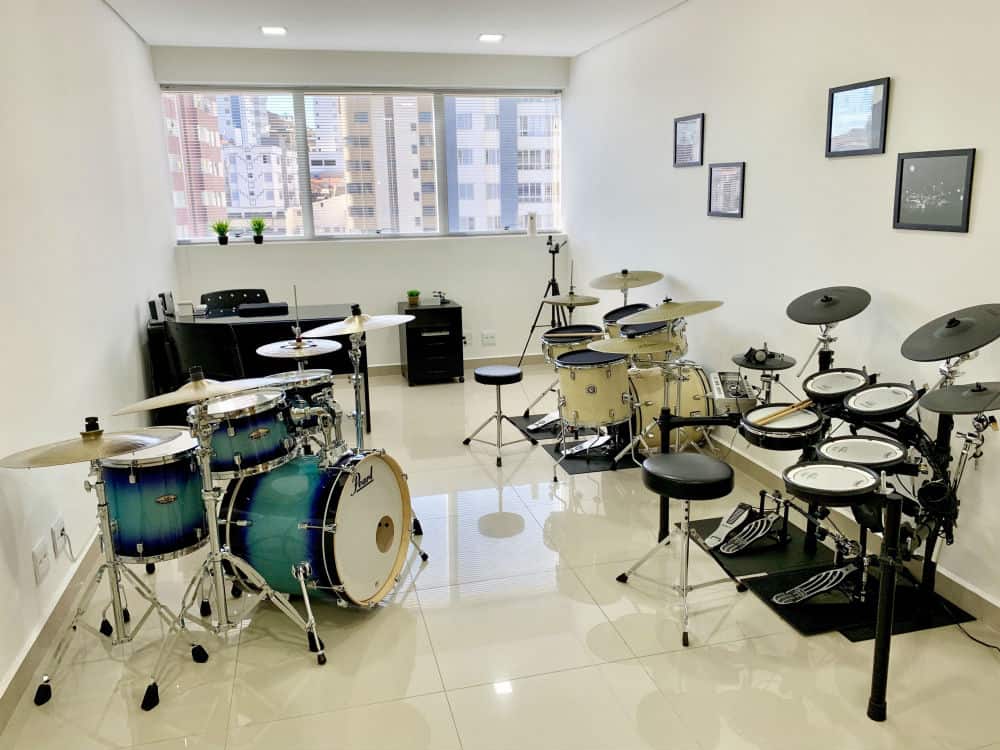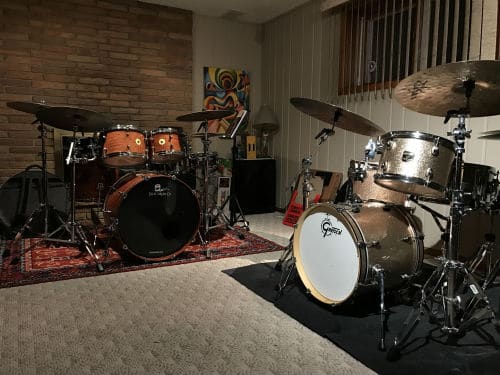Last Updated on May 24, 2021 by Danny
While drumming kits are a fun and engaging instrument to play, they are pretty loud for an average home. You’ll not only bother those who you live with, but there’s a chance your neighbors will be disturbed by the noise as well. But don’t worry, as there are always ways to soundproof your rooms and make it all work. You only need to reduce the amount of sound coming from your drum set by 10 dB less than a drummer who generated 110–120dB when playing harder. And that can be done by either sealing the gaps or air leaks in doors, windows or by using soundproofing materials. This is why we decided to do this brief guide where we’ll explain how to soundproof a room for drums, aka the drum rooms. From the door to the last detail, we have you covered.

Decide the budget for the room
But before going into the process of soundproofing a room for drums, or even deciding on the perfect drumming room in your home, you’ll need to set a budget. While there are cheaper ways to soundproof your drum room, it’s always a better solution, in the long run, to invest more into it.
But if you’re looking for budget options for soundproofing for drum room, then first start with all the possibly DIY soundproofing options, like having softer furniture and covering windows or any metal surfaces with dampening materials. But just remember that this won’t ever be enough to really make it worthwhile and you’ll always need to prepare funds for soundproofing a drum room, whether it’s the door or any other component.
Reducing vibration translated through the walls/floors/ceiling
When you play drums or play loud music in general, the sound waves go in all directions. Some may focus solely on soundproofing walls or the area in close proximity to the drums, but this is not exactly the perfect choice. First, you need to find the gaps or air leaks to reduce the vibrations going through the floors, with walls and ceiling too. You can even create your custom soundproof mat or buy the best sound absorbing drum mat.
For the floor, it’s important to use a thicker drum rug and carpet. Aside from reducing vibrations, they’ll also serve as good sound absorption. As for the ceiling, drywall constructions in combination with wool or foam materials can be pretty useful, just like with surrounding walls. Hence instead of building a fully soundproof drum room, it is best if you use some absorptions techniques which reduce the amount of sound coming from your drum room.
A good place to start here is to place the drums in the basement

But the best way to start is to find the perfect room for drums in your home. If you place the instrument in your basement, you immediately get rid of a few important problems right from the very start. Sure, maybe the door could use some isolation, but the rest is pretty much all set.
You don’t need to worry about bothering anyone beneath your designated room and it will be easier to isolate sound since it’s already underground. Of course, you’ll still need to do soundproofing and add absorbing materials. But soundproofing basement for drums will be a simpler, and probably even a cheaper option compared to other rooms in your home.
In some settings, however, other problems may arise. Since we’re talking about basements here, there’s a chance that you’ll have problems with higher humidity. In order to keep your kit’s components safe from any longterm humidity-related damages, it would be a good idea to sort it out first, which can increase the overall cost for the room.
Surrounding the kit with sound-absorbing materials like dense blankets

Aside from isolating floors, walls and ceiling, you can also dampen the sound by adding some additional sound-absorbing materials around your drum. One of the simplest solutions is to go with thick blankets and find a way to put them around your kit. You can always make custom DIY frames that will either hold these blankets or use any other kind of dampening material.
You can create your absorber panels using a wooden frame, some kind of acoustic foam. If you’re using mineral wool or any other insulation material, you’ll need to secure it tightly with some kind of fabric going over it. When done properly, this solution works better than thick blankets around your drum. But either way, you’ll need to surround the kit in order to reduce the drum noise.
[amazon bestseller=”dense blankets” order_items=”5″ template=”table” button_text=”Check Latest Price” filterby=”title” filter=”South Wind” filter_type=”exclude”]Sound dampening riser

Whether it’s a basement or any other room in your home, creating a custom riser for your drum set is a great soundproofing option. Of course, it would be easier to create one in your basement, since you don’t need to worry that much about damaging the floor with additional construction. But when done properly, you can use it in any part of your home.
For this, you’ll need to know the exact surface where your drum components will go, and possibly even add some surface in there for more flexibility. Then create a small drum riser from wood and plywood, and then add an adhesive carpet on top of it. Aside from soundproofing, it will also make your home studio look cool from the moment someone enters the door.
[amazon bestseller=”Sound dampening riser” order_items=”5″ template=”table” button_text=”Check Latest Price” filterby=”title” filter=”LICHIFIT” filter_type=”exclude”]Use an electric kit

If all this sounds too complicated for your home if you don’t have funds, or if you just don’t feel like you want to soundproof a drum room, the solution is simple – use an electronic drum kit.
You can find a good electronic kit for a reasonable price these days and it will provide you with a pretty realistic feel. Aside from silent practicing using headphones or speakers on lower volume, you can also use this kit for recording and even live gigs. What’s more, they’re really easy to transport. No need to isolate anything, not ever the door to the room. Read our in-depth guide on recording drums.
Mesh heads
But if you want to keep it acoustic, adding mesh heads to your drum components will significantly lower the noise. These specialized drum heads will give you the same exact feeling with low volume. So although soundproofing for the drum room is important, the addition of mesh heads helps as well.
[amazon bestseller=”Mesh heads” order_items=”5″ template=”table” button_text=”Check Latest Price” filterby=”title” filter=”LICHIFIT” filter_type=”exclude”]Low volume cymbals
And there are also low volume cymbals for practice that will provide you with the same feel, good sound, but significantly lower volume. They’re not that expensive, and in addition to mesh heads, they can be a much more affordable option than completely building a drum room from scratch.
Look into bass traps
Every good studio invests in the so-called bass traps. These are relatively big chunks of specially-designed absorbing materials and are usually placed in corners. And the main purpose of these big chunks of isolation material is to dampen all of the lower frequencies of the audible spectrum. This is extremely useful if you want to soundproof a room for drums since the bottom-end frequencies are really problematic.
Drum Room Sound Absorption Solutions
When soundproofing a room, the best solution is always to completely isolate it with drywall constructions that also involve mineral wool or similar materials. You’ll also need to think of windows, doors, and other hard surfaces, as they’ll also need special methods. There are plenty of them, but the more hard surfaces are there, the more expensive it gets. Cheaper solutions here involve putting any kind of mattresses or chunks of foam material over the doors and windows.
Additional solutions also include the aforementioned drum risers, thick carpets, or some budget-friendly solutions like using foam over the walls and using custom-made absorbers around the drum. Additionally, you can invest in additional door isolation, and more.
FAQ
In the following section, we are going to discuss some of the crucial steps for managing your soundproof room for drums, including sound absorption, door, and more.
How much does it cost to soundproof a room for drums?
The costs vary depending on the room size, type of materials that you want to use, and the availability of these materials. The costs get significantly higher if you want to hire someone to do it for you. Overall, covering an average room that’s around 300 square feet can get anywhere from $500 and up to $4,000 or more. If you’re going with drywalls and regular quality materials, your typical price range can go from $1,000 to $2,000.
How do I soundproof a drum room for cheap?
Finding the cheapest way to soundproof a room for drums is not that easy. The simplest solution is to go with a basement, to get an electronic kit, or low-volume cymbals and mash skins. As for acoustic drum sets, cheap methods for a soundproof room for drums, like custom frames with old blankets and mattresses, are far from a perfect solution but can help you to some extent. You can also use Evans SoundOff mutes to drastically reduce the volume up to 60-70% via 360 degrees of acoustic panels.
Conclusion
In this concise guide, we covered the key points of soundproofing a drum room and optimizing it for practice. If you follow all the steps above, you will be able to reduce the amount of sound significantly and will keep neighbors happy. We hope that you now feel more informed and confident about the topic – and even inspired to get down to work. Stay safe and rock on, guys!